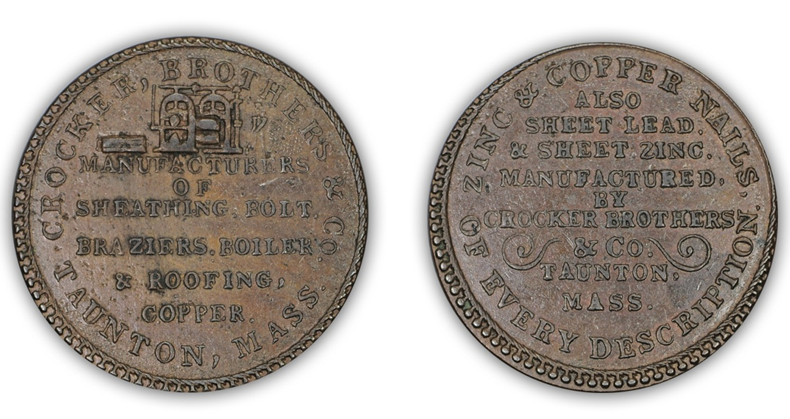Copper for cents and half-cents
 RogerB
Posts: 8,852 ✭✭✭✭✭
RogerB
Posts: 8,852 ✭✭✭✭✭
Cent and half-cent coinage. Sources of sheet copper and planchets.
“In 1794-5, sheet copper alone was purchased for this purpose. It continued to be used for a few years after.
“In 1796, the first invoice of copper planchets was received from the ‘Governors and Company of Copper Miners in England.’
“From 1798 to the present date, planchets have been purchased from the Boultons, Birmingham.
“Since 1834 the mint has also been supplied by Crocker & Co. of Taunton, Mass.”
The above accompanies a table of copper prices paid by the Mint 1794 through 1836.
2
Comments
Mint of the United States
Philadelphia, May 1, 1837
Gentlemen,
After a thorough examination of the Copper planchets received by Schooner Samuel Crocker, and which were damaged in consequence, as we were told, of her having been sunk, the Chief Coiner states that he considers the injury equal to two cents in the pound, and we therefore shall require that a deduction to this amount be made from your bill, thus making the cost 30 cents instead of 32.
The Planchets assured, in your letter of the 28th ult., as sent with New York, have not yet come to hand. When they do, your bill shall be attended to.
Robert Maskell Patterson
Director
To:
Crocker Brothers & Co.
Taunton, Massachusetts
Imagine... a formal letter to document a deduction of two cents for product deficiencies... how times have changed.... Cheers, RickO
1832 Crocker Bros. storecard Ex: John Ford

RMR: 'Wer, wenn ich schriee, hörte mich denn aus der Engel Ordnungen?'
CJ: 'No one!' [Ain't no angels in the coin biz]
Nice transcription!
That's 2-cents per 100-lbs of planchets. Context is especially important in these older documents.
Most coastal trade was handled by cargo schooners. These shuttled between ports and rarely went beyond the continental shelf. When they sank, not an uncommon event, the shallow water made recovery of their cargo worthwhile. As can be seen from the letter posted by MsMorrisine, non-perishable cargo often made its way to its destination; sometimes in usable condition.
Crocker Brothers was the first American source of planchets for large cents and half cents (beginning in 1832 according to Bob Julian, 1833 according to Dick Doty), and the sole source after 1838. The token that I posted above actually depicts a tiny Crocker Brothers employee in long work gloves operating a sheet metal rolling mill, just the kind of machine that would have allowed them to roll copper ingots into sheet for use on large cent planchets.
RMR: 'Wer, wenn ich schriee, hörte mich denn aus der Engel Ordnungen?'
CJ: 'No one!' [Ain't no angels in the coin biz]
I assume that was two cents per 100 pieces?
I don't know Capt., could have been.... that would make sense. Cheers, RickO
Planchets were bought by weight, not count.
"Start date" of purchases depended on whether it was based on a contract or a single purchase. All three dates might be correct.
Very nice and appropriate storecard, thanks for posting it.
Successful transactions with : MICHAELDIXON, Manorcourtman, Bochiman, bolivarshagnasty, AUandAG, onlyroosies, chumley, Weiss, jdimmick, BAJJERFAN, gene1978, TJM965, Smittys, GRANDAM, JTHawaii, mainejoe, softparade, derryb, Ricko
Bad transactions with : nobody to date
The letter is correctly transcribed except for one word. The sentence
reading “... injury equal to two cents in the present, ...” should read
“... injury equal to two cents in the pound, ...”
There were 41.67 large cent planchets to the pound.
Some of these letters are very difficult to read.
Ahhh....Thank you! That changes the meaning considerably. Two cents per pound reduction was a a little over 6% off the bill.
Yep, these things can be difficult to decipher.
18370501 Damaged copper planchets.pdf
I concur
"pound," not "present"
which brings me to the next item on the list.
my next batch is done as well as I can get them.
instead of emailing me feedback, just send me the final files and I can learn from them. These type of word errors will also be reduced as I learn from your contemporary vocabulary and head slapper corrections.
oh, and these cents and half cents were being shipped to NY in Kegs.
Blank planchets for large cents are known in at least two varieties, with narrow upset rim and a wide upset rim. The planchets with the wide upset rim are known to be used with later-date large cents, and the narrow ones with earlier date pieces. There might also be a third variety but the details escape me. @FredWeinberg might remember the details.
Traditionally the cutoff between the two varieties was determined by date, but looking at the unstruck portion of dated off-center strikes. Based on the information in the OP, it sounds like the broad rims were from Crocker and the narrow rims were from the Boultons. I don't remember hearing that before. It might be new information...
The problem is a little more complicated than it appears on the
surface. There was a third supplier of cent planchets from 1816
to about 1832, Belles & Harrold of Birmingham, England. And while
Crocker Brothers supplied most of the cent planchets after 1837,
there were occasional other suppliers, such as Selah Hiler.
For half cents, however, it is a little easier. All half cent planchets
from 1800 to 1835 were supplied by Boulton and all such planchets
after 1848 were made by Crocker Brothers.